Sapphire Radeon R9 290 Tri-X OC Review: Our First Custom Cooled 290
by Ryan Smith on December 24, 2013 3:45 PM EST- Posted in
- GPUs
- AMD
- Radeon
- Sapphire
- Radeon 200
Overclocking
Our final evaluation criteria is overclocking. Since the 290 Tri-X OC is based on AMD’s reference board, the card has the same overclocking functionality and capabilities as any reference card. Which is to say that we have voltage control and monitoring, but the board itself is not particularly engineered for extreme overclocking. At the same time the nature of putting together a card like the 290 Tri-X OC means that Sapphire is doing some degree of binning,
| Radeon R9 290 Overclocking | ||||
| Sapphire Radeon R9 290 Tri-X OC | Ref. Radeon R9 290 | |||
| Shipping Core Clock | 699MHz | 662MHz | ||
| Shipping Boost Clock | 1000MHz | 947MHz | ||
| Shipping Memory Clock | 5.2GHz | 5GHz | ||
| Shipping Boost Voltage | ~1.18v | ~1.18v | ||
| Overclock Core Clock | 824MHz | 790MHz | ||
| Overclock Boost Clock | 1125MHz | 1075MHz | ||
| Overclock Memory Clock | 6GHz | 5.6GHz | ||
| Overclock Max Boost Voltage | ~1.23v | ~1.18v | ||
For overclocking the 290 Tri-X OC, we increased the PowerTune limit by 20% and the voltage by 50mV to what’s roughly 1.23v. Out of this we were able to get another 125MHz (13%) out of the GPU and 800MHz (15%) out of the VRAM, now topping out at 1125MHz for the GPU boost clock, and 6GHz for the VRAM. The final clockspeeds are better than our previous efforts at overclocking our reference 290 (which was prior to voltage control), although only moderately so.
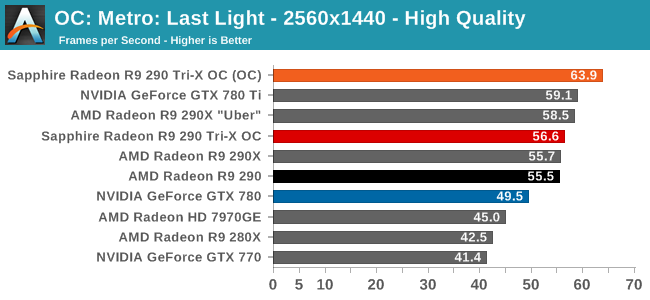
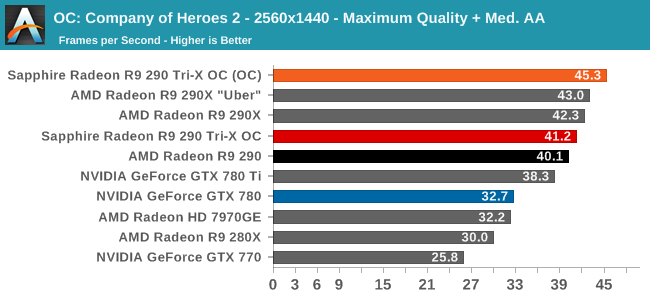
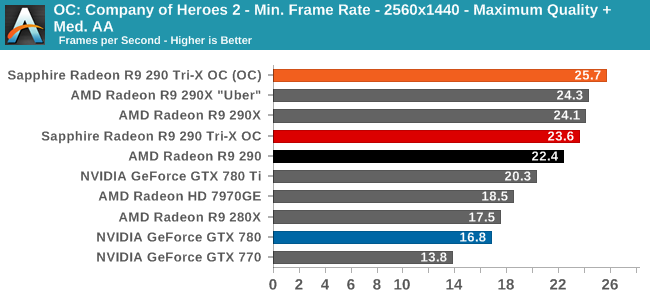
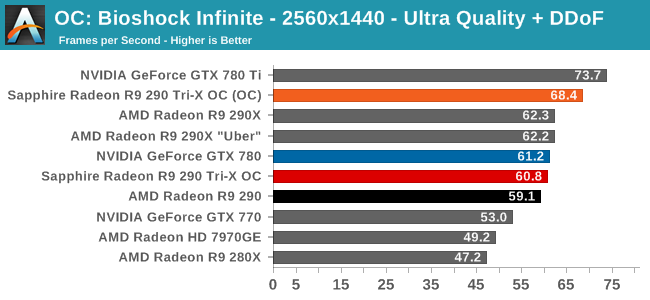
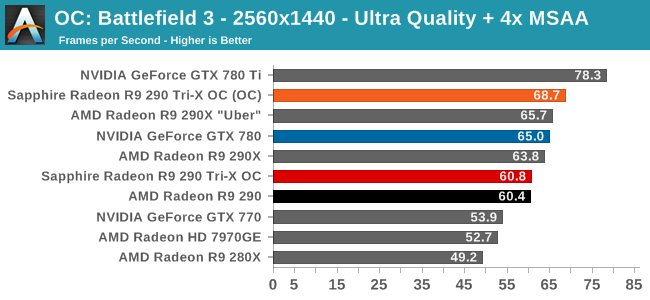
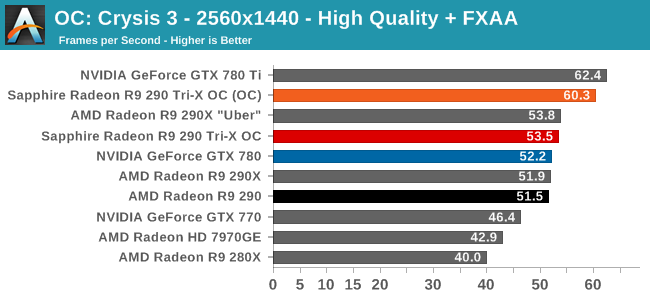
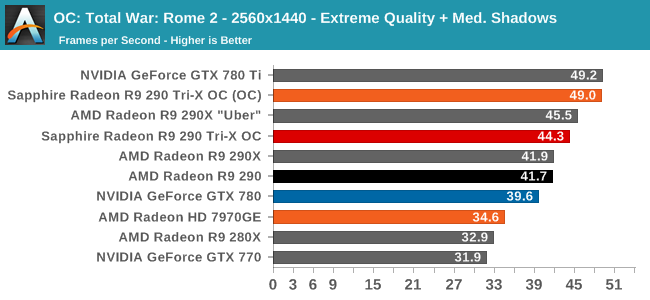
Starting first with gaming performance, as a more extensive overclock relative to Sapphire’s factory overclock, the performance gains from our own overclocking have yielded very solid results, despite the fact that this isn’t explicitly an overclocking board. Between the 13% core overclock and 15% memory overclock, the average performance increase measures in at 12%, varying depending on whether a game is more bandwidth limited, GPU limited, or CPU limited.
At 12% faster the overclocked 290 Tri-X OC is fast enough to largely close the gap between it and the reference GeForce GTX 780 Ti. Otherwise it will consistently outscore the 290X in “uber” mode, even in spite of the pared down nature of the Hawaii GPUs used in 290 cards.
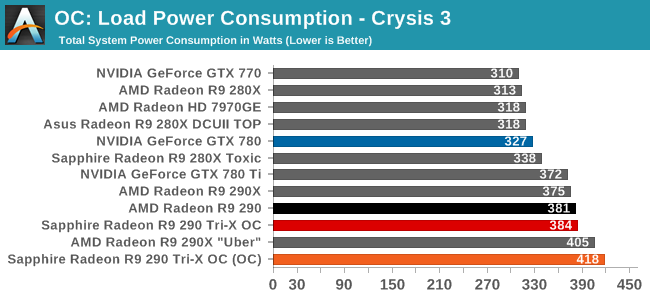
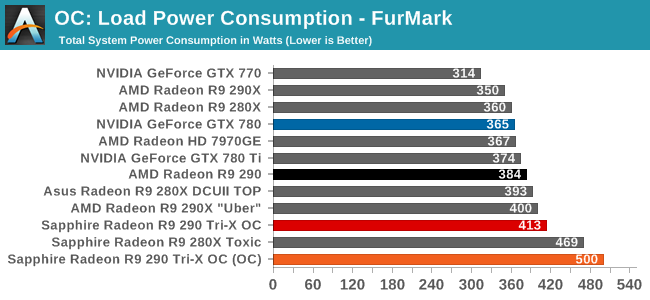
The power consumption penalty for overclocking is significant, but outside of the outright power limited FurMark, is not unreasonable. Under Crysis 3 the additional 13% in performance comes at a cost of 30W at the wall, most of which will be from the video card.
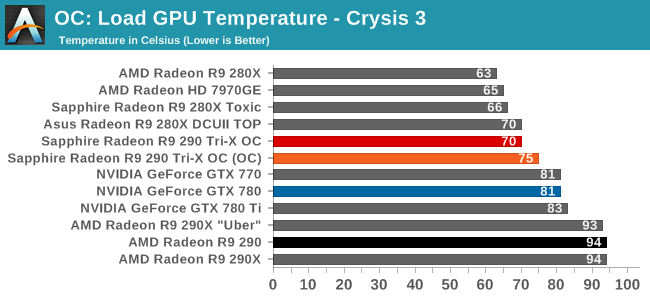

Along with power consumption overclocking also comes with the expected increase in operating temperatures. Under Crysis 3 this is an increase of 5C to 75C, while for FurMark (where the increase in power was greater) this is an additional 7C to 81C. FurMark definitely gives the Tri-X cooler a harder time when the video card is overclocked, but as this is a worst case scenario it also means that operating temperatures should still remain well under 80C, as evidenced by Crysis 3.

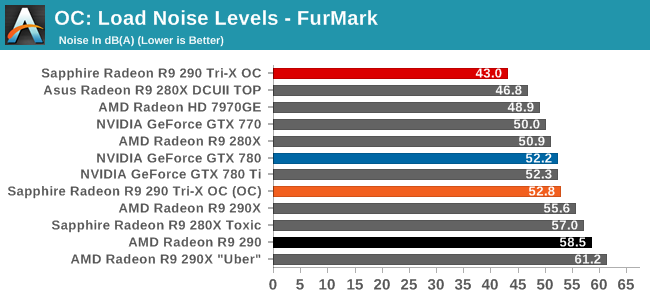
Even with our overclocking the 290 Tri-X OC still holds up rather well when it comes to Crysis 3. At 45.6dB this is a 4.5dB increase in noise, more than enough to be noticed, but notably it’s still quieter than our stock 280X and 7970GE, both of which are similarly open air coolers. FurMark on the other hand pushes the card much harder since it’s reaching the new 120% PowerTime power limit, leading to a jump in noise of just under 10dB to 52.8dB. Even faced with an overclocked FurMark the Tri-X cooler is still holding up very well, though we’ve clearly reached the point (with regards to thermal loads) where it has lost its near-silence.










119 Comments
View All Comments
Ryan Smith - Thursday, December 26, 2013 - link
Huh. I had thought I had fixed that. Thanks!Duelix - Thursday, December 26, 2013 - link
Can't wait for a Direct CU II model from Asus. A R9 290 with a decent cooler is stupid fast for the money. Take that, Nvidia!hoboville - Thursday, December 26, 2013 - link
It's really amazing how on some games the 780 Ti is 10-20% faster, and then slower in others. If that performance were consistent across all game titles, the 780 Ti might just be worth the price.Then again, $700 card vs $450 card means it costs more than 50% more! What can you say then other than: if you have the budget for a 780 Ti, save another $250 bucks and get a 2nd 290.
Brent20 - Tuesday, December 31, 2013 - link
The problem with that thinking is the AMD cards do NOT sell for $450, ANYWHERE. They are selling for 50% OVER retail price.r13j13r13 - Thursday, December 26, 2013 - link
me orgasmeoooooooooo pero con la con la version 290x iguala a la 780 tirandinspace - Friday, December 27, 2013 - link
"Sapphire is essentially charging $50 for a better cooler..."It's worth noting that what with the voiding of the warranty that follows installing an aftermarket cooling solution on a reference card the $50 premium Sapphire is charging is probably worth it in the long run.
toyotabedzrock - Friday, December 27, 2013 - link
The almost perfect scaling of performance with the over clock is interesting. If AMD would allow them to do the same with the 290x it would allow them to outright beat the 780 ti.ggathagan - Monday, December 30, 2013 - link
An important note for owners of cases that rotate the motherboard 90 degrees (Silverstone Fortress 2, etc...):The Asus DirectCU, the HIS IceQ X² and the MSI FrozrII lines orient the heatsink fins in a way that can take advantage of the bottom-to-top airflow of those cases.
Custom cooled solutions from Sapphire, EVGA, XFX, Gigabyte and MSI all orient the cooling fins of the heatsink perpendicular to the airflow in such cases.
Mopar63 - Tuesday, December 31, 2013 - link
This sounds like it might matter but it does not. The fins are oriented so they are essentially across the airflow of any case design. The air flow however is not enough to be an issue against the direct air pressure of the GPU fans and the exhaust is then whisked away by the air flow currents of the case.If there was ANY difference in temps it might be 1 or 2 C at the MOST.
Brent20 - Tuesday, December 31, 2013 - link
If you want the review to be fair, I think its time that all these AMD reviews reflect the REAL inflated price that the card sells for when comparing it to the competition, which is about 50% over retail value.AMD will die off as a gaming card company as long as they continue to cater to the "mining" users. Mark my words. Why buy a card for 50% over retail, and a card that is rarely in stock anywhere.
They need to put something in to block mining use. They may make big bucks off it now, but in the long run its going to hurt their "gaming" business badly.
Perhaps they could block the mining in the gaming card and make a separate card for mining and sell it at quadruple the price. As the miners appear willing to pay any price for it.